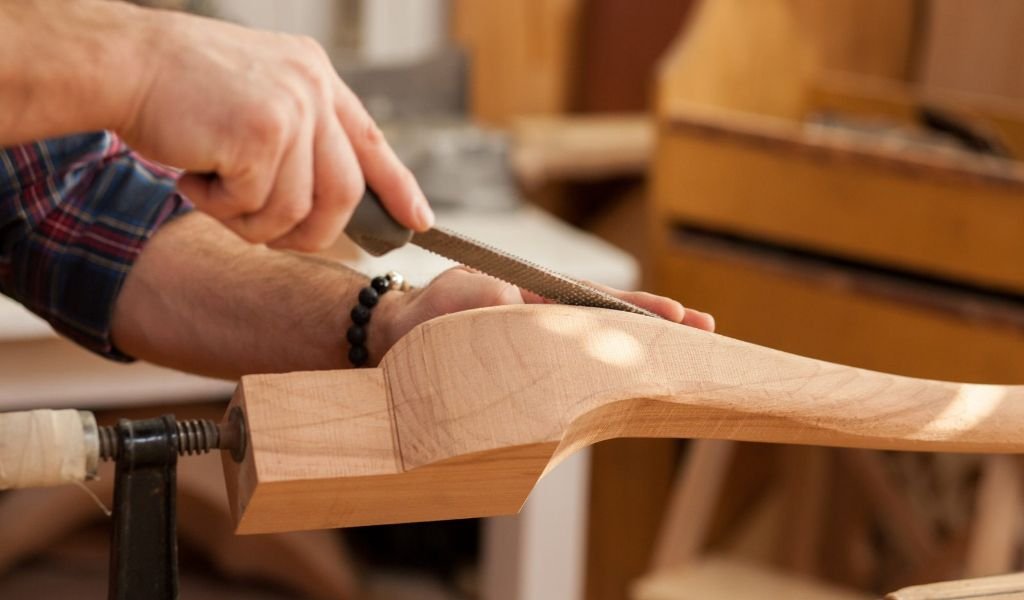How to Add Legs to Furniture?
Are you tired of your furniture sitting so low to the ground? Do you wish you could give your beloved pieces a little lift? You do not need to search any further! This blog article by Design Furniture will demonstrate how to add legs to furniture to improve the piece’s appearance and usefulness. Whether it is a table, chair, or dresser, giving antique furniture legs may give it new life and that additional bit of flair you have been looking for. As we give furniture legs, be ready to get messy.

What You Need
Adding legs to furniture requires certain instruments and materials. To complete this task, you will need the following materials.:
T Nuts
First up, T nuts. These little gems are essential for attaching legs securely to furniture. They have a threaded hole that allows you to screw in the leg bolt and create a strong connection.
Threaded Inserts
Threaded inserts are another must-have item. These cylindrical pieces with internal threading can be inserted into wood or other materials, providing a sturdy base for attaching legs.
Metal Sheets, Both Straight and Angled
Remember straight and angled metal plates! Straight metal plates are great for reinforcing joints or adding stability to corners. Angled metal plates come in handy when you want to attach legs at an angle, giving your furniture a unique look.
Wood Mounting Blocks
Wood mounting blocks are also useful components in this process. They provide additional support and stability when attaching legs to certain types of furniture.
Use of Straight or Single Angled Cleats
Straight or single-angled cleats may provide legs to furniture. This helpful hardware may support and style your furniture.
- Flat surfaces benefit from straight cleats. Screw or nail them to your furniture’s underbelly. Straight legs make installation straightforward and secure.
- Single-angled cleats are best for adding legs at an angle. These cleats connect to furniture and legs at an angle. This strengthens the leg-furniture relationship.
- Whether you choose straight or single-angled cleats depends on your needs and preferences. Straight cleats work well for simple designs with flat surfaces, while single-angled cleats are ideal for adding visual interest with angled legs.
- No matter which type of cleat you choose, follow proper installation instructions and use quality materials. This will ensure that your newly added legs are secure and durable.
Now that you know about using straight or single-angled cleats, you can transform your furniture by adding stylish new legs!
Remove Furniture Skirting
- Adding legs requires removing furniture skirting. Skirting covers structural components and unattractive parts on the bottom of furniture. Removing it gives your remodeled artwork a contemporary vibe.
- Start flipping or tilting the furniture to expose the bottom and remove the skirting. Carefully remove skirting screws and nails using a screwdriver or drill. To reattach the skirting later, keep note of all hardware.
- After removing all screws and nails, carefully peel off the skirting. Avoid damaging nearby woodwork. Some adhesive may remain after removing the skirting. Using a scraper or sandpaper removes glue from the furniture’s underside and leg attachment points.
- Removing furniture skirting simplifies leg installation and opens up customizing options. Adding legs, whether metal or wood, can revitalize your item!
Measuring and Cutting the Legs
- Measuring and cutting furniture legs ensures they are of the proper height and length. Start with a tape measure, pencil, and saw.
- Measure the floor-to-bottom distance of your furniture. This will indicate how long your legs should be for support. Consider adding height.
- Next, draw in the leg lengths. Consider stability and attractive angles and cuts. Measure twice before cutting.
- Cut following the lines using a saw suited for cutting wood or metal, depending on your legs. Slowly and steadily make clean slices.
- After trimming all four legs, tie them to your furniture.
Drilling Holes for the Legs
Stabilizing your furniture requires drilling leg holes. Before starting, measure and mark the leg attachment points.
- Choose a drill bit that matches the diameter of your T nuts or threaded inserts. Legs will fit snugly. To avoid movement during drilling, secure your furniture.
- Start drilling by placing the drill bit on one of the indicated areas and applying consistent pressure. Avoid pushing too hard or going too rapidly to avoid wood splintering.
- Clear wood chips and debris as you drill each hole. This ensures clean and precise leg-attachment holes.
- Test fit each T nut or threaded insert after drilling all holes. Fit snugly without moving. Gently hammer them in.
- Repeat these instructions for each furniture leg before fastening them firmly!
Adding the Legs
Adding furniture legs is fun! After your preparations, give your item fresh vitality and solidity.
- First, ensure you have T-nuts or threaded inserts, straight or angled metal plates, and wood mounting blocks. These will support the legs firmly.
- Next, arrange your furniture for simple leg attachment. For increased movement, turn it over or prop it up on blocks.
- Mark the leg attachments with a measuring tape and pencil. Consider height changes and uneven surfaces.
- Use a suitable drill bit to drill pilot holes at each designated position. Inserting screws afterward will not break or fracture.
- Attach those lovely new legs! Line up T-nuts or threaded inserts in pre-drilled holes. Secure them with a screwdriver or Allen wrench.
- After attaching all legs, gently jiggle them to confirm stability and levelness. Adjust before continuing.
Finishing Up
After adding legs, there are a few last measures to protect and beautify your furniture.
- First, tighten all screws and connections. To check stability, wiggle each leg. Tighten loose screws using a screwdriver or wrench.
- Step back and appreciate your effort! Note how the new legs changed the aesthetic of your furniture. The additions are wonderful.
- Add padding or felt to each leg if desired. This will protect your flooring from furniture movement.
- Maintain your freshly improved furnishings. Follow the leg-adding materials’ directions. Clean and check for damage regularly.
Conclusion
By following these steps and using the right tools and materials like T-nuts, threaded inserts, metal plates, and wood mounting blocks – you can easily add legs to your furniture like a pro! Whether you want to improve stability, change the style, or simply give an old piece new life – this DIY project is both satisfying and cost-effective. Do not be afraid to try out some wild concepts. With just a little time and effort spent on adding legs to your furniture pieces, you’ll be amazed at how much they can enhance their functionality and aesthetic appeal in no time!




